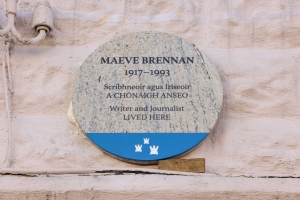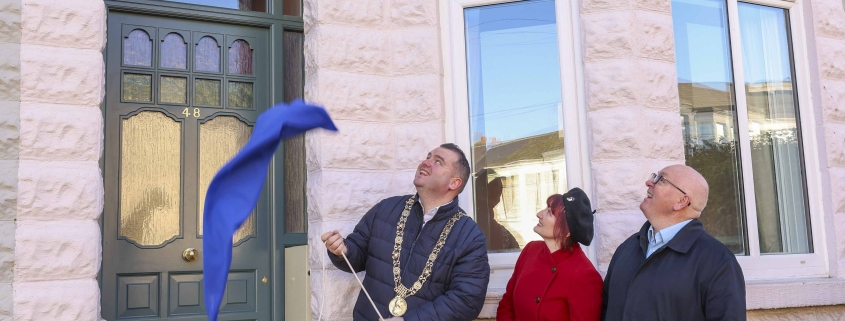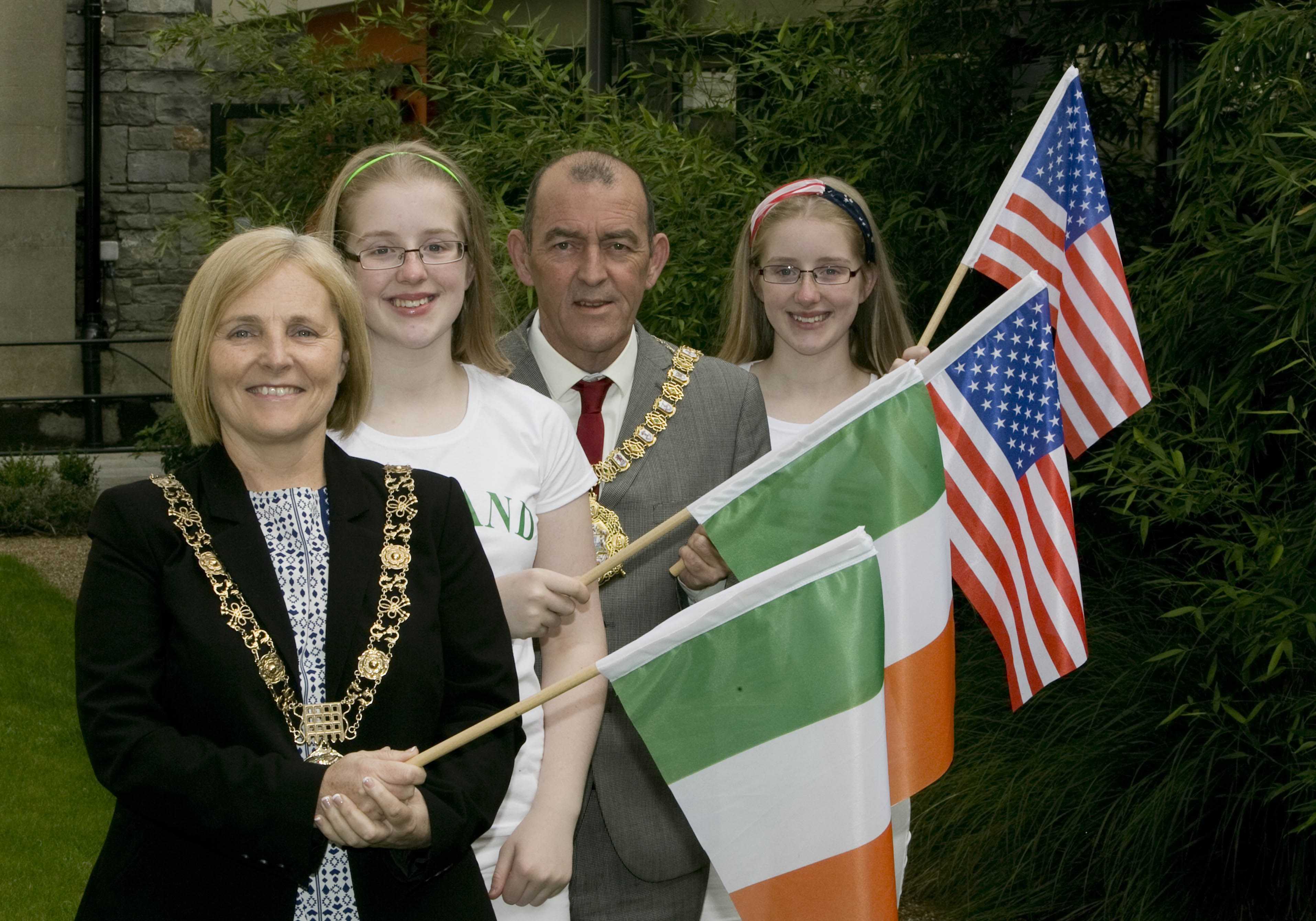Dublin City Council unveils plaque to Dublin born literary giant Maeve Brennan, ‘the greatest Irish writer you never heard of’
Dublin woman Maeve Brennan, whose rediscovered writings have won her world wide recognition in the literary world, has been commemorated by a Dublin City Council Commemorative Plaque. The plaque was unveiled by Lord Mayor Daithí de Róiste at 48 Cherryfield Avenue, Ranelagh, Ms Brennan’s childhood home.
Speaking at the unveiling, Lord Mayor of Dublin Daithí de Róiste said, “Did Maeve Brennan know her time would come? That we would gather to pay tribute to her today at the house that inspired so much of her writing and became a character in so many of her stories, in the multi cultural, forward looking city of Dublin, thirty years after she died in relative obscurity? Like the great creative mind that she was, she would have reflected that time has a way of putting things to rights, of healing and rising above the humdrum to reach a higher level. 48 Cherryfield Avenue was “the home of her imagination,” as William Maxwell described it, her great mentor at the New Yorker magazine. Maxwell had good reason to know that she never owned a place of her own, because at one stage she was sleeping in his office. This house in Ranelagh was the only home she had.”
Maeve Brennan, once described as “the greatest Irish writer you never heard of,” was born in Dublin on 6th January 1917, second of four children of the journalist Bob Brennan, who would go on to found the Irish Press.
After her father was selected as Ireland’s ambassador to Washington in 1934, Ms Brennan completed her secondary and third level education in Washington and moved to New York to work in a library. There her literary talent was noticed by the editor of New Yorker magazine. For three decades she contributed to the New Yorker and had two critically acclaimed collections of short stories published in 1969.
While fighting a losing battle against financial and mental health problems, she retreated into obscurity and spent her last years in a home for the elderly in New York, her talent unknown to her carers and, in the end, herself. It was only after her death in 1993 that her work was anthologised and recognised by a new generation of writers and critics, placing Maeve Brennan among the best Irish short-story writers since Joyce. Her works have been accepted into the canon of twentieth century literature:
- In and Out of Never-Never Land, her first collection of 22 short stories published in 1969, set in Dublin or New York, went largely unnoticed in Ireland where so many of them were set. They reflect a range of human experiences, from domestic life to the complexities of memories and personal histories. Through a mix of humour, melancholy, and sharp social commentary, delving into themes of alienation, identity, and the search for a sense of place. Quote: “an exile is a person who knows of a country that made all other countries seem strange.”
- The Long-Winded Lady. A compilation of essays Maeve Brennan wrote for “The New Yorker” under the pseudonym “the Long-Winded Lady” first anthologised in 1969 and published in an expanded edition by William Maxwell in 1998. These essays offer a glimpse of New York City life through the small, often overlooked details of the city and its inhabitants over the course of two decades. Quote: ‘We are real only in moments of kindness.”
- The Springs of Affection. A collection of short stories mostly set in Dublin, which paints intimate portraits of marriages, childhood, and the burdens and small transcendent moments of everyday life. They delve into the complexities of family life and the subtle dynamics within, focusing on the quiet tragedies and joys that shape her characters’ lives. Quote: “She had forgotten all that was familiar to her in her struggle to stand by the one who had made it all familiar.”
- The Visitor: An unpublished novella discovered in 1997 amongst the papers of her publisher in the library of the University of Notre Dame. Written in 1944, it follows the story of Anastasia King, who returns to Dublin after a six-year absence in Paris following her mother’s death. She is confronted by her grandmother’s coldness and must face the chilling loneliness of a home that is no longer hers. It’s a tale of disillusionment and the cutting ties of familial relationships. Quote: “Home is a place in the mind. When it is empty, it frets. It is fretful with memory, faces and places and times gone by. Beloved images rise up in disobedience and make a mirror for emptiness. Then what resentful wonder, and what half-aimless self-seeking. Comical and hopeless, the long gaze back is always turned inward.”
- The Rose Garden: Another collection of short stories published posthumously in 2000 mainly set in the Hamptons or the Hudson Valley where she lived through a short lived chaotic marriage to an alcoholic fellow writer, drawing on themes of love, memory, and change. Quote: “They were marked for life by their ravenous hopes,” writes the sublime Brennan (1917-93). “They had the glittering, exploring eyes of people who have never learned to control their dreams.”
Through these re-publications, a new generation of readers has embraced the themes she illuminated: migration, portability, remembrance, and the significance of material objects in building a home. 
The decision to erect the plaque was made by the Dublin City Council Commemorations & Naming Committee. Maeve O’Regan, owner of 48 Cherryfield Avenue, proposed that the plaque be erected.
Notes to the Editor
For more information about Maeve Brennan, see her entry in the Dictionary of Irish Biography: https://www.dib.ie/biography/brennan-maeve-a0928
Listen Back to the Dublin City Libraries & Archives podcast ‘Walking in Maeve’s Shoes’:
https://soundcloud.com/dublincitypubliclibrary/walking-in-maeves-shoes
The Plaques Scheme
Dublin City Council’s Commemorative Plaques Scheme is intended to facilitate the formal commemoration of people, organisations, and events that have made a unique and significant contribution to the life or history of Dublin through outstanding achievement, distinctive service or significant community contribution.
Proposals to commemorate living persons will not be considered.
Nominees will have to have died at least 20 years previously or have passed the centenary of their birth, whichever is earlier.
Members of the public can propose a commemorative plaque on the official form.
Full details, including the application form and the list of plaques erected so far, can be found at www.plaquesofdublin.ie












